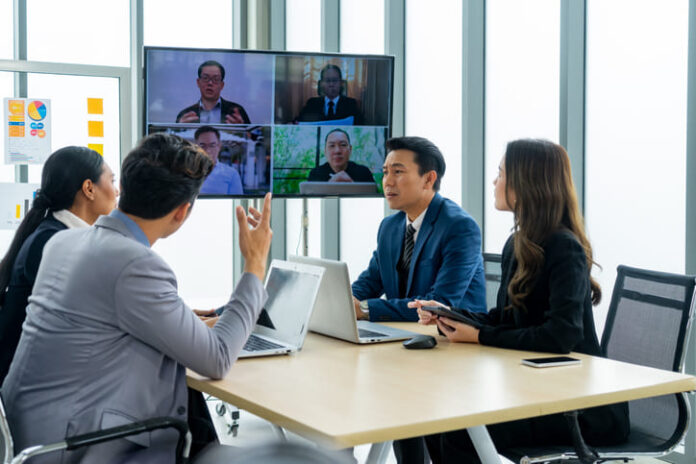In an era dominated by digital interactions, some companies still hold steadfast to the traditional values of face-to-face communication. O’Neil Franso, Corporate VP of HR at H.W. Kaufman Group, a multinational insurance parent company, shared how their “handshake culture” integrates with the modern hybrid work model when I interviewed him.
Embracing Hybrid Work Without Losing Personal Touch
Franso emphasizes H.W. Kaufman Group’s dedication to maintaining personal interactions with clients, a principle they call “handshake culture.” Before the pandemic, the company didn’t practice much remote work. However, COVID-19 forced a shift, and they had to adapt quickly.
“We believe in a handshake culture, meaning face-to-face interactions with our clients. COVID-19 forced us to embrace remote work and navigate a hybrid schedule,” Franso explains. Initially, the company expected to revert to in-person work after the pandemic. However, they soon recognized the benefits of hybrid work, which now plays a crucial role in their operations.
“We emphasize the value of being in person but also recognize the quality that comes from allowing people the flexibility to work from home,” Franso adds. This flexibility has proven essential for attracting and retaining talent, ensuring a better work-life balance, and maintaining productivity.
Attracting Talent Beyond Geographic Boundaries
One of the significant advantages of hybrid work for H.W. Kaufman Group has been the ability to attract talent irrespective of location. “Remote work allows us to get the talent regardless of location,” Franso says. This flexibility enables the company to find the right people for the job, even if they are not based in major metropolitan areas.
By leveraging remote work, the company has found success in reducing the need for frequent travel, thus enhancing productivity. “It allows people to travel more and accomplish business targets that we otherwise wouldn’t if we were chained to our physical desks,” Franso notes.
Flexibility as a Tool for Employee Well-being
The shift to hybrid work has also brought numerous benefits to employees. “Flexibility allows a better work-life balance, helping us attract and retain talent and manage burnout,” Franso says. Employees can avoid lengthy commutes, stay closer to their children, and work at their peak productivity without distractions.
Interestingly, this flexibility has also resonated with clients who face similar challenges. Franso shares that clients appreciate the alignment in working hours, often engaging with employees late at night when both parties are working from home. This shared experience has fostered stronger connections and enhanced client relationships.
Investing in Physical Spaces for Collaborative Work
Unlike some companies that have reduced their real estate footprint, H.W. Kaufman Group has taken a different approach. They invest in creating better physical spaces to meet the diverse needs of their employees. “We’re furnishing fantastic physical spaces for our people, recognizing that most employees want to come into the office at least part of the time,” Franso explains.
The emphasis on in-person interaction supports collaboration, osmosis, and training, enhancing the overall client experience. “It wasn’t about saving money on real estate. In fact, we probably ended up investing more to create better spaces for people to come in,” Franso says.
Addressing Managerial Challenges in a Hybrid Environment
The transition to hybrid work has not been without challenges, particularly for managers adapting to new styles of supervision. “Understanding the needs of our people and managers and then creating common ground is probably the biggest challenge,” Franso acknowledges.
To address this, H.W. Kaufman Group encourages more frequent one-on-ones and video meetings with cameras on to facilitate effective communication. “The most meaningful communication is nonverbal—facial expressions, body language. You can’t get that in a chat or text message,” Franso explains. Video meetings help replicate the in-person experience, allowing for better performance evaluation and feedback.
Supporting Junior Employees Through Structured Mentorship
For junior employees, who often need more exposure to experienced colleagues, the company emphasizes in-office interactions. “Our less experienced employees and newer employees are asking for more days in the office to learn and overhear conversations,” Franso says.
H.W. Kaufman Group has implemented buddy programs and continuous mentorship beyond initial onboarding. Managers are trained to understand the type of mentorship needed and either provide it themselves or assign a team member. “We find that when you assign mentors during onboarding, they become lifelong collaborators,” Franso notes.
The Future of Flexible Work
Looking ahead, H.W. Kaufman Group sees the future of flexible work as fluid and evolving. “It requires active management, research, trial and error, and flexibility to adapt to changing business needs,” Franso explains. The company remains committed to creating schedules that fit their business objectives and stakeholder needs.
“There’s no one-size-fits-all solution. It requires work, commitment, and grit,” Franso concludes, highlighting the importance of finding the right talent aligned with this mindset.
In a world where remote work is becoming the norm, H.W. Kaufman Group’s handshake culture offers a balanced approach, integrating the best of both in-person and remote work to foster strong client relationships and employee well-being. The focus on balancing employee experience with client needs reflects a theme I always emphasize with my clients when helping them overcome the frustrations of implementing hybrid work models, and I’ll be citing Franso’s words as a great example of how to achieve such balance.
About the Author

Dr. Gleb Tsipursky was named “Office Whisperer” by The New York Times for helping leaders overcome frustrations with hybrid work and Generative AI. He serves as the CEO of the future-of-work consultancy Disaster Avoidance Experts. Dr. Gleb wrote seven best-selling books, and his two most recent ones are Returning to the Office and Leading Hybrid and Remote Teams and ChatGPT for Thought Leaders and Content Creators: Unlocking the Potential of Generative AI for Innovative and Effective Content Creation. His cutting-edge thought leadership was featured in over 650 articles and 550 interviews in Harvard Business Review, Inc. Magazine, USA Today, CBS News, Fox News, Time, Business Insider, Fortune, The New York Times, and elsewhere. His writing was translated into Chinese, Spanish, Russian, Polish, Korean, French, Vietnamese, German, and other languages. His expertise comes from over 20 years of consulting, coaching, and speaking and training for Fortune 500 companies from Aflac to Xerox. It also comes from over 15 years in academia as a behavioral scientist, with 8 years as a lecturer at UNC-Chapel Hill and 7 years as a professor at Ohio State. A proud Ukrainian American, Dr. Gleb lives in Columbus, Ohio.


































































